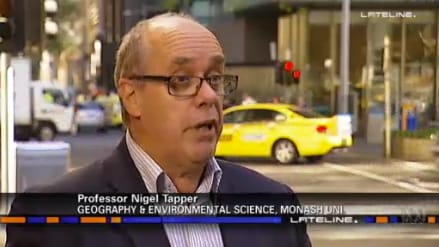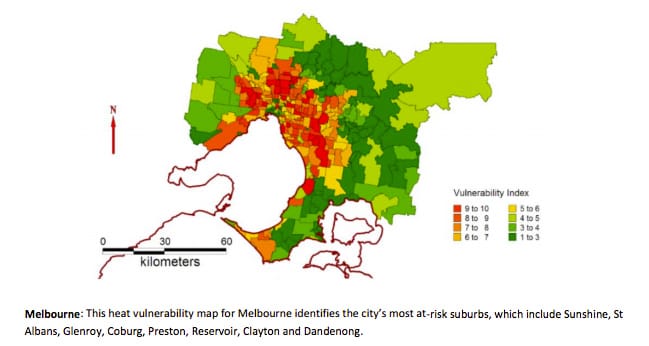CRCWSC’s Professor Nigel Tapper discusses urban heat impacts on ABC’s Lateline
 Urban heat features strongly across all Australian cities, often associated with higher densities of vulnerable groups such as the elderly, the poor, or culturally and linguistically diverse communities. In areas that are covered by buildings, urban warming can increase local temperatures by around 4°C, which can take the temperature over the threshold where human health is threatened.
Urban heat features strongly across all Australian cities, often associated with higher densities of vulnerable groups such as the elderly, the poor, or culturally and linguistically diverse communities. In areas that are covered by buildings, urban warming can increase local temperatures by around 4°C, which can take the temperature over the threshold where human health is threatened.
Professor Nigel Tapper, co-Leader of the CRC for Water Sensitive Cities (CRCWSC) Water Sensitive Urbanism program, was interviewed in Monday night’s ABC Lateline episode during a story on urban heat in Australian cities. Increasing urban heat is a critical issue for our cities and towns, and the CRCWSC welcomes the media attention this issue has received over the last six months.
CRCWSC researchers, in partnership with the National Climate Change Adaptation Research Facility (NCCARF), have identified threshold temperatures above which mortality and morbidity increase in all Australian capital cities, and have developed a mapping tool to identify areas of high vulnerability during extreme heat events.
Researchers have also found that heat extremes and the number of days exceeding the critical heat‑health thresholds are projected to increase in all Australian capital cities in the coming decades. Highlighting the areas most affected by extreme heat allows a targeted response and a focus for urban planning and policy. The vulnerability maps can be used for emergency response planning by hospitals, the ambulance service and local government to protect vulnerable residents and to plan for the future.

The CRCWSC continues to examine methods of combating the urban heat island effect using principles such as water sensitive urban design (WSUD). WSUD uses green infrastructure (vegetation, rain gardens and green walls for example) and water in urban environments to engineer a cooling effect to offset urban heat. Research by the CRCWSC has found that this approach is effective in mitigating urban heat, and could be used by local governments and urban designers to help protect residents from dangerous urban temperatures.
The video and accompanying print story can be accessed here: https://www.abc.net.au/news/2014-06-02/city-designs-must-change-in-face-of-deadlier-heatwaves-experts/5494124
To see how different suburbs rate in terms of urban heat, go to: https://sites.google.com/site/mappingvulnerabilityindex/home
To read a CRCWSC brief on urban heat, and how water sensitive urban design can be used to mitigate the urban heat island effect, click here.